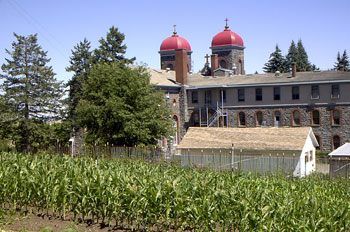February 28, 2003
Air Date: February 28, 2003
FULL SHOW
SEGMENTS
Green Dream Deferred
View the page for this story
Writer Lis Harris followed Allen Hershkowitz through his ill-fated attempt to bring a paper recycling mill to the South Bronx. Harris tells the story, chronicled in her new book “Tilting at Mills,” in an interview with host Laura Knoy. (11:00)
Health Note/De-worming RX
/ Diane ToomeyView the page for this story
Living on Earth’s Diane Toomey reports on a possible new source for a drug to treat the millions of animals and humans infected with parasitic worms. (01:15)
Almanac/Merzbacher Lake
View the page for this story
This week, we have facts about Merzbacher Lake in Kyrgyzstan. This glacial lake was discovered 100 years ago and just about every year since, its icy dam has broken and released a deluge in the valleys below. (01:30)
Eco-friendly Road Assistance
View the page for this story
Better World Club is trying to win away members of the American Automobile Association, pointing to, what they call, AAA's not-so-environmental lobbying record. Host Laura Knoy talks with Better World's president Mitch Rofsky about the alternative. (00:04)
Ethiopian Java Crisis
/ Anne Marie RuffView the page for this story
The coffee bean was discovered in Ethiopia more than a thousand years ago. Since then, coffee has become the leading export of the east African nation. But a surplus of coffee beans on the world market has caused the prices to drop so substantially that Ethiopian farmers are having to look for other ways to make a living. Anne Marie Ruff reports. (07:00)
Baby Talk
View the page for this story
Host Laura Knoy talks with Gerald McRoberts, a psychologist at Lehigh University, who’s found men and women really differ when it comes to baby talk. (03:00)
Emerging Science Note/Hydrogen Power
/ Cynthia GraberView the page for this story
Living on Earth’s Cynthia Graber reports on a technique to get hydrogen from wastewater at food production plants. (01:20)
Hopi Tribe Seeks to Reclaim Water From Peabody Energy
/ Daniel KrakerView the page for this story
The Hopi Indian Tribe in Arizona gets eighty percent of its income selling coal, and water used to transport the coal to the Peabody Coal Corporation. But now, the water is running out and the tribal members must decide if their water is more precious than the money that they make selling it. Arizona Public Radio’s Daniel Kraker reports. (10:00)
Lewis & Clark Trails
View the page for this story
Another of our occasional stops along the Lewis and Clark Trail to meet the folks who live on that famous route today. Producer Barrett Golding meets the Sisters from the Monastery of St Gertrude in Idaho, where caring for the land is part of their faith. (05:30)
This week's EarthEar selection
listen /
download
Show Credits and Funders
This Week's Music
Show Transcript
HOST: Laura KnoyGUESTS: Lis Harris, Mitch Rofsky, Gerald McRobertsREPORTERS: Anne Marie Ruff, Daniel KrakerNOTES: Diane Toomey, Cynthia Graber
[MUSIC UP]
KNOY: From NPR, this is Living on Earth. I'm Laura Knoy. Coming up, the tale of a far-reaching plan to build an eco-friendly recycled paper mill in the heart of New York City.
HARRIS: It started off with a tremendous bang. The city was enthusiastic, the Department of Sanitation was looking for markets for its paper, and it started out very well.
KNOY: But, all did not end well. Green dreams deferred, this week on Living on Earth.
Also, as coffee prices tumble worldwide, farmers in Ethiopia abandon the bean for a more lucrative crop.
MELES ZENAWI: Some of the farmers are uprooting their coffee trees and replacing them with qat trees. It's a mild narcotic. The social implications of such a shift are very serious.
KNOY: And the environmental implications are serious, too. The java jive in Ethiopia, and more, when we return, right after this.
[NPR NEWSCAST]
ANNOUNCER: Support for Living on Earth comes from the National Science Foundation and HeritageAfrica.com.
Green Dream Deferred
[THEME MUSIC]
KNOY: Welcome to Living on Earth. I'm Laura Knoy, sitting in for Steve Curwood. And this is Allen Hershkowitz, a staff scientist with the Natural Resources Defense Council, from a story that aired on Living on Earth back in 1998.
HERSHKOWITZ: We're going to be producing less CO2 than virgin mills. We're going to be producing less sulphur dioxides than virgin mills, less nitrogen oxides, less particles. We're going to save 3.4 million trees a year. We're going to save 10,000 acres of forest a year.
KNOY: At the time, Mr. Hershkowitz and the environmental group NRDC were charging full-steam ahead with plans to build a state-of-the-art recycled paper mill in the South Bronx. The goal was hundreds of jobs for neighborhood residents, eco-friendly paper for New York's huge publishing industry, and a pioneering partnership between business and environmental groups.
Didn't quite turn out that way, though. After eight years of community conflicts, politics, and financial setbacks, the dream collapsed. Lis Harris covered the story for The New Yorker magazine as it unfolded. Now she's written a book about the woebegone paper plant called “Tilting at Mills: Green Dreams, Dirty Dealings and the Corporate Squeeze.” She says it all started with Allen Hershkowitz and the NRDC, and their idea that environmental groups should be more proactive about pollution.
HARRIS: So he thought, all right, let's do it ourselves. Let's design something from the ground up. And let's make business see that this is something that they can make a profit from. And let's get a community--instead of being our enemies, or the enemy of a project--in on it. And he, with great good luck, he found a superb Swedish paper company developer, his name is Per Batelson, who was as enthusiastic as he was about the environmental aspect of production in the paper industry, and shared his dismay about the way things were and had been going. The paper industry is one of the most conservative in the world. It's been using methods that it's used since the middle of the 19th century, it hasn't changed them, and they have no interest in changing.
So they got together and it went--it started off with a tremendous bang. Everybody was very enthusiastic. The city was enthusiastic, the Department of Sanitation was looking for markets for its paper, and it started out very well.
KNOY: If all had gone according to plan, what kind of facility would we see today in the South Bronx?
HARRIS: We would have seen a state-of-the-art, 100 percent recycled, chlorine-free newsprint mill that was designed by environmentalists to repair environmental damage, clean up a contaminated industrial site, alleviate poverty in the South Bronx--which is a chronically depressed area. It would have recycled 400,000 tons of waste paper each year and used and recycled hundreds of millions of gallons of contaminated sewage water. And it would have been the largest industrial manufacturing facility to come to the city since the second World War.
KNOY: You mentioned, also, economic benefits. What type of jobs were we talking about, and how many?
HARRIS: The highest estimation was around 600 permanent jobs. There would have, of course, been many thousands of construction jobs, but probably around 600 permanent jobs for people in that community. And also designed into the project, very unusually for a large industrial project, were benefits to the community--a health facility, a learning center--because part of the structure of the plant was to include a community development group in the structure of the way it was run.
KNOY: It really sounds like a utopian dream, you know, jobs and daycare and healthcare and everything.
HARRIS: Well, it was designed so that these groups who, over the last several decades, have always been at each other's throats--either in court or at hearings--businesspeople, enviros, community activists. It was designed so that the barriers toward making projects that were good for business so they could make money; good for the environment so they could be built well, good for the community so they could get jobs, would finally be working together instead of always being at each other's throats. That was the idea.
KNOY: So, when did the trouble start?
HARRIS: A ripple of trouble that was very shocking started at the very beginning, when the--Allen and the people he was working with, and some city officials--went to Stockholm to meet with the people from the Swedish company. And the mood was incredibly up and exciting and happy and optimistic.
And around that period, not long afterward, someone from the group the South Bronx Clean Air Coalition asked Hershkowitz for some money in order to not make trouble for them. And as far as Allen was concerned, since their aims were only good for the community and benign in terms of environmental impacts, he couldn’t imagine what they were talking about, and he asked what trouble. And he was just told in a sort of vague way that there would be trouble, but it could be helped if some money could be given to this person. And that was the beginning of a climate of accusation from that group-- because the money was never forthcoming--and a lot of stirring up of opposition that dogged them really throughout the project.
KNOY: Well, who were the major opponents?
HARRIS: Well, as I say in the book, this was a death by a thousand cuts. The paper industry, according to many people in the paper industry I talked to behind the scenes, was working in sort of various nefarious ways. They kept throwing sort of sums of money at the project, making the people think that they were behind it, and they would withdraw at the last minute. There were a lot of nasty politics afoot.
KNOY: I was really struck, Lis, by how many classic conflicts that always come up in American society--white/black conflict, Democrat/Republican conflict, sometimes black/Latino conflict--all these classic conflicts landed on this poor project's head.
HARRIS: That's right. There's a great suspicion of environmentalists and white people, in general, who come into poor neighborhoods where there are a lot of people of color. For one thing, a lot of community activists have the view, which is a correct view, that environmentalists were notably absent when the dumps and incinerators were coming there, and they're very suspicious of their motives.
But this project was designed in such a benign way, from that point of view, and it was hard for people to accept that. The Bronx borough president was a Democrat, Mayor Giuliani was a Republican. The Bronx and its interests were very far from his political base. He was never--he made some sort of statement at the very beginning of this that it sounded good, and seemed to be behind it, but he never really did throw his support to it. Had he thrown his support to it, had the paper been promised all along from the beginning in a more definite way, I think the project might well have happened.
KNOY: You said earlier, Lis, that this was a project that died of a thousand cuts. What ultimately killed it?
HARRIS: I think two or three things, actually, ultimately killed it. One of them was the state. Governor Pataki was a big supporter of this, although on sort of a slightly--on an echelon slightly below him there were people who were not so behind it. But Governor Pataki many times helped this project with promises of bond support and all kinds of aid. In order for it to work, the community partner that they had, a group called Banana Kelly which was one of the shining stars of the community development movement for many decades--unfortunately, its leader became a not-good partner. She became sort of a slum lord, in fact. And having a group associated with this project that the Attorney General began to investigate, and that tenants complained about, was kind of one kiss of death for this. Because people could not support a project associated with somebody apparently doing things of the kind that she was.
And then the market turned bad for paper. It was a very good market when the project began. Two lawsuits became involved, and the second one frightened NRDC enough, because they were--although Allen had scores of people working with him--engineers, Merrill Lynch, business people of all kinds--he was seen as spearheading it, and they were very vulnerable. He was seen as a developer which he wasn't really. But he was a coordinator, and they withdrew from it. And I think the withdrawal of NRDC was the final kiss of death because then an ordinary, a large business took over. A construction company took over, and the aims became far more purely business aims, and it got too large, and it couldn't get the bonds. When it got too large, I think that was the kiss of death.
KNOY: The title of your book, “Tilting at Mills,” obviously refers to the story of Don Quixote and his fight with a windmill that he thought was a giant. Is, or should I say, was Allen Hershkowitz Don Quixote?
HARRIS: Actually, the title does not refer to Don Quixote…
KNOY: It does not? Okay.
HARRIS: No, it does not. The verb tilting--if you look it up in the dictionary, one of the meanings of it is simply charging, as in jousting. People charged against their enemies. And the sense of the book is really that he is trying to--well, he is trying to put the old chlorine-using, dioxin-producing, polluting mills either out of business, or getting them to see that some of them could use this. And, of course, some people regarded him as a Don Quixote figure. It seemed impossible to some of them.
But let's look at what really happened. I mean, many of the things that he wanted to happen, happened. The polluted site was cleaned up, the permits were gotten, hundreds of thousands of dollars--millions of dollars--were raised. There was a plan in place to change the water, the sewage water of New York City from Ward's Island, and make it into grey water to use there.
It's not that it couldn’t happen. It's that it couldn't happen at that point, and I don't think he is a cuckoo visionary at all. I think this actually will happen. Several things have to be in place. An industrialist has to be behind it. At the beginning of this project, there was a Swedish industrialist from the paper industry, very respected, behind it. That company unfortunately changed their global development plans and they withdrew. Had that company been in there, they might well have. And secondly, it has to have a civic leader, like a mayor, behind it. And this, unfortunately, this project did not have that.
KNOY: Lis Harris is a former staff writer at The New Yorker and author of the book “Tilting at Mills: Green Dreams, Dirty Dealings, and the Corporate Squeeze.” She is also an associate professor of writing at the School of Arts at Columbia University. Lis, thanks for joining us.
HARRIS: Thank you. I enjoyed it.
[MUSIC: Ali Akbar Khan “India Blue” A World Instrumental Collection Putumayo World Music (1996)]
Related link:
Tilting at Mills: Green Dreams, Dirty Dealings, and the Corporate Squeeze
Health Note/De-worming RX
KNOY: Just ahead, coffee: a brewing controversy over the future of Ethiopia's economy and environment. First, this Environmental Health Note from Diane Toomey.
[MUSIC: Health Note Theme]
TOOMEY: One out of every four people on the planet is infected with parasitic worms called nematodes. Nematodes are also major agricultural pests attacking crops and livestock. Others, like heartworm, infect pets. There has been increasing concern that nematodes are developing resistance to drugs used to treat these infestations. But now, research at the University of California at San Diego offers hope for a safe, low-cost alternative.
For decades, organic farmers have fought off nematodes with a natural insecticide derived from a bacterium known as Bt. A number of genetically-modified crops have also been engineered to produce the Bt insecticide. The toxin acts by dissolving the intestines of insects that ingest it.
Humans and other vertebrates lack the kind of cellular receptors needed for the toxin to work, so exposure to Bt has been shown safe for people. Until now, Bt hadn't been tested on nematodes, but the UC/San Diego team found that all six nematode species used in this experiment were affected by Bt, either killing them outright, damaging their intestines, or reducing their number of offspring. Researchers say it's possible that a drug derived from Bt toxin could be developed as an effective remedy against nematode parasites in humans and other animals.
That's this week's Health Note. I'm Diane Toomey.
KNOY: And you're listening to Living on Earth.
[MUSIC: Ali Akbar Khan “India Blue” A World Instrumental Collection Putumayo World Music (1996)]
Almanac/Merzbacher Lake
KNOY: Welcome back to Living on Earth. I'm Laura Knoy.
[MUSIC: Vanilla Ice “Ice Ice Baby” To The Extreme]
KNOY: One hundred years ago, German explorer Gottfried Merzbacher led an expedition through the Tien Shan Mountains in modern Kyrgyzstan. There, on the western edge of the Himalayas, he discovered a remote glacial lake. In a lengthy chronicle of his travels, he hardly mentions the lake that now bears his name. But he just saw it on the wrong day. Later, visitors learned of its dynamic nature. Almost every year, Merzbacher Lake appears, expands, dies a spectacular death, and is reborn. Its evolution takes place in a steep, virtually inaccessible valley where two glaciers meet. When the spring sun begins to melt the ice, water flows into the valley, collects on top of the glacier's ice, and is penned in by an ice dam.
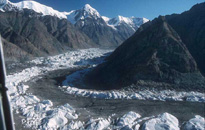 |
 |
|
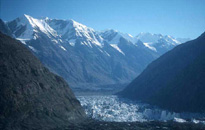 |
 |
|
| (Photos: Stephan Schoen / Saechsische Zeitung (Dresden)) | ||
At the peak of its cycle, the lake has an area of about five square kilometers. But by then it's late summer, the temperature is rising, and like a bottle of fine champagne, a cork of ice pops out from the base of the dam and water bursts free in an icy explosion. In just three days, the lake disappears and the cycle begins again.
Even one hundred years after its discovery, westerners still don't know much about Merzbacher Lake. Scientists are currently investigating the area's geology, and updating Soviet-era maps of the region using satellite images to better understand this natural wonder.
And for this week, that's the Living on Earth Almanac.
Eco-friendly Road Assistance
[ENGINE TURNING OVER]
KNOY: Okay, it's late at night and your car breaks down in the middle of nowhere. Like almost 45 million other Americans, your next move is obvious: you call the American Automobile Association to come rescue you. But now, a new organization called Better World Club is trying to steal away AAA's more environmentally-friendly members. Mitch Rofsky is Better World's president. Mr. Rofsky, why do we need an environmental alternative to AAA?
ROFSKY: AAA, at various times, both at the state and/or the federal level, has opposed the Clean Air Act, has opposed mass transit funding, even has opposed bike paths. And the environmental community was pretty frustrated about it. We thought, gee, that's really interesting. Certainly, our policy agenda would vary from that. But, at the same time, we thought there were just all kinds of issues surrounding transportation that you could do a lot of innovative things with that AAA, and I don't want to single them out, that no other automobile club is doing.
KNOY: AAA says you are kind of skewing their position, a false dichotomy they call it, that yes they're for roads, but they're also for mass transit. They say it's really, you know, it's about balance.
ROFSKY: Well, actually, that's what we say. We say that it's about balance. And, really, I encourage anybody who wants to, to look at AAA's record. They have essentially said that people's interests as motorists should come first.
KNOY: So Mitch, how does Better World Club help people minimize the impact of their travel on the environment?
ROFSKY: First of all, the centerpiece of our effort is what's called a carbon offset program to fight global warming. What that means is that when you fly you're putting almost a ton of carbon dioxide and other greenhouse gas into the atmosphere per person, per domestic round trip. What we do is we work to offset that. We take a portion of the ticket price and we donate that to nonprofit groups, for example Portland School System, to help them replace old oil-burning furnaces with natural gas furnaces.
We're about to announce that we're going to do the same thing with cars, for people who buy insurance from us. Third, if we have any money leftover after our carbon offset programs, we're looking to--because we want to give away one percent of our gross to various environmental efforts--we're looking at cleaning up locations where our customers go. So, we're looking at beach cleanup and ski resort cleanup. We also provide discounts on eco-tourism, green hotels, and try to promote those as much as we can.
KNOY: What's the roadside bike program? I'm picturing myself sitting by the side of the road with a flat bicycle tire. It's happened a lot of times.
ROFSKY: Well, essentially, if you call us we'll send somebody out who will attempt to fix the bicycle. And if they're not able to fix it, they will then take you to the destination of your choice. It basically covers 30 miles over two service calls a year.
KNOY: I can think of a couple times when I could have used that. But the real test, Mitch--for most people AAA is synonymous with help. And they're in bad situations, and AAA comes in and helps, and that's what people want from these types of programs.
Just a couple weeks ago, I had a dead battery. I called AAA. They were there within half an hour, they fixed it and they were gone, and it was wonderful. Would I have had the same experience if I called Better World?
ROFSKY: Most likely you would have had exactly the same experience. The way it works is that there are six national towing networks around the country. AAA is obviously the best-known. You don't know the names of the other five because they basically service various industries. So, as you may know, Laura, when you buy a car you sometimes get roadside assistance with it. The car manufacturers aren't doing roadside assistance themselves, they're contracting with one of these networks. We've contracted with one of the networks that provides a service to much of the insurance industry, as well as the warranty industry. Our network has been around for over 20 years.
The important thing about these networks is that for the most part they're nonexclusive. As a result, the same people who pick you up for AAA and likely to be the same people who pick you up for us. They all have the same goals, that is, to get to you within 45 minutes. What we say is we provide you with the same roadside assistance that AAA does, but other than that we're completely different.
KNOY: Mitch Rofsky is the president and cofounder of Better World Club. Thanks for joining us.
ROFSKY: It's been my pleasure.
Related links:
- Better World Club
- AAA
Ethiopian Java Crisis
KNOY: Coffee is the most widely traded agricultural commodity in the world. The planet's most popular stimulant is grown in more than 50 countries by more than 25 million people. The multi-billion-dollar coffee industry got its start in Ethiopia more than a thousand years ago, and coffee remains Ethiopia's largest export.
But world coffee prices have fallen to their lowest levels in 30 years, and Ethiopian farmers are having a hard time making a living. As Anne Marie Ruff reports, it's affecting both the nation's economy and environment.
[SINGING AND MUSIC]
RUFF: In the village of Choche, in the lush mountainous highlands of southwest Ethiopia, local musicians sing about their home.
[SINGING AND MUSIC]
RUFF: Nearly all of the thousand or so residents of Choche have turned out to hear the music, and to welcome agriculture officials and members of western non-governmental organizations.
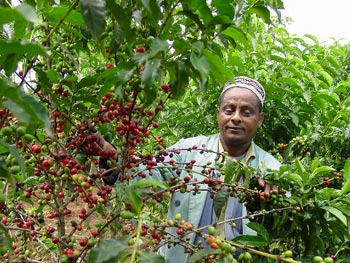
A Muslim coffee farmer in Choche, Ethiopia.
(Photo: Anne Marie Ruff)
The visitors have come to see how an international crisis in the coffee market is affecting farmers in Choche, one of Ethiopia's main coffee-growing areas. According to legend, it was here that coffee was discovered, when a shepherd noticed that his sheep became unusually energetic after eating coffee berries. To this day, most farmers in Choche have spent their entire lives growing coffee on small farms.
[SHEIK TAJA NURU SPEAKING ]
MALE VOICEOVER: This is the only thing that we have around, only coffee. The coffee we produce is a class coffee.
RUFF: Sheik Taja Nuru is proud of the coffee he produces, but the deep wrinkles on his 45-year-old face belie the problems that confront coffee farmers.
[SHEIK SPEAKING]
MALE VOICEOVER: We are working day and night. We are thin by labor, but are not getting anything out of it. Because of the fall of the price, we don’t get any profit, we are hurt because of this.
RUFF: Choche’s farmers harvest coffee berries, which are then sold to a processor or a farmer's cooperative. The seeds of the coffee berries are then processed into coffee beans. The price Choche's farmers receive for their unprocessed coffee berries has fallen 90 percent in the last ten years. The three cents a pound they now earn is not enough to clothe their families, send their children to school, or buy food for more than one meal a day.
Zarihun Alemayo echoes farmer Sheik's frustration. He works with coffee farmers to organize them into cooperatives so they have more influence in the market.

Sorting coffee berries at a coffee cooperative in Choche, Ethiopia.
(Photo: Anne Marie Ruff)
ZARIHUN: And we claim that God gave us coffee, and we gave it to the world. And for this gift it seems that the world is not paying us.
RUFF: The situation in Ethiopia is being repeated in almost every coffee-growing country. The supply of coffee used to be regulated by the International Coffee Organization, which imposed export quotas on its coffee-producing member countries. But in 1989, the U.S., the biggest importer of coffee, withdrew its membership, and the International Coffee Agreement collapsed. Vietnam and Brazil, especially, responded by flooding the market with cheap, lesser-quality coffee that drove prices down. In Ethiopia, the low coffee prices aren't only hurting farmers, but the nation's economy as a whole.
[SOUND OF BEANS BEING POURED]
RUFF: In Ethiopia's main coffee warehouse in the capital of Addis Ababa, coffee beans are big business. Coffee makes up about 60-70 percent of the country's exports and generates most of the taxes that fund the government. Ethiopia's prime minister, Meles Zenawi, is running a government nearly bankrupt from lack of tax revenues. He says farmers are responding to low coffee prices by abandoning coffee for more lucrative crops.
MELES ZENAWI: Some of the farmers are uprooting their coffee trees and replacing them with qat trees. It's a mild narcotic. The social implications of such a shift are very serious.
RUFF: Fresh qat leaves are profitably exported to Yemen, Djibouti, and Somalia. Qat is also starting to be exported as an illegal drug to the U.S. and Britain, where it fetches as much as $180 dollars a pound in East African communities. The growing drug trade has environmental implications. Qat will not grow in the forest; it requires full sun. So farmers who convert from coffee to qat are cutting down forests, forests that traditionally shade Ethiopian coffee plants, in order to do so.
Government officials say they have few statistics about the scale of recent crop conversion, or figures about how much forest has been lost. But Barbara Fiorito says the situation is serious. She's the chair of the board of Oxfam America, an international advocacy organization dealing with issues of poverty.
FIORITO: So, many thousands of acres in the rain forest that exist are there because coffee is grown underneath this high umbrella. So, therefore, if the coffee price continues to decline, and more coffee land is turned under, there will be logging because there will be no need for the high canopy that protects the best coffee in the world.
RUFF: Oxfam has launched a coffee rescue plan to urge business and political leaders to take immediate action. Since half of the world's coffee is bought by only five companies--Procter and Gamble, Kraft, Sara Lee, Nestle and the German company Tchibo--Fiorito thinks their actions are key.
FIORITO: We are asking the coffee companies to, one, increase the quality of the coffee that they are buying. We are asking them to contribute to a fund to destroy five million bags of this over-supply of coffee that is in reserves at this point.
RUFF: Oxfam is also promoting Fair Trade coffee as part of the solution. The Fair Trade seal on coffee packages means that it has been bought directly from farmer's cooperatives. Oxfam also proposes a fund to help farmers from other coffee-producing countries, such as Vietnam, to find alternative ways of making a living.
Workshet Bekele is a major exporter of Ethiopian coffee. He thinks Oxfam's proposals are encouraging, but he believes they won't go far enough.
WORKSHET: It's a good effort but as far as I see it, I think in order to bring fair trade to all, you have to bring a quota system.
RUFF: Workshet says that if the U.S. is serious about helping poor countries, they need to rejoin the International Coffee Organization, so that farmers can get a decent price for their high-quality coffee.
For Living on Earth, this is Anne Marie Ruff in Choche, Ethiopia.
[MUSIC: Baka Beyond “Spirit of the Forest” A World Instrumental Collection Putumayo World Music (1996)]
Related links:
- OXFAM coffee report
- U.S. Hearing 7/24/02 – Coffee Crisis in Western Hemisphere
Baby Talk
KNOY: We'd like to offer you an opportunity to visit a coffee plantation in Africa, and also spend the night on the rim of a dormant volcano. Thanks to Heritage Africa, Living on Earth is giving away a 15-day trip for two on an ultimate African safari, with visits to several of Africa's premier game preserves, including Kruger and Serengeti National Parks. Go to our website, loe.org, for more details about how to win this 15-day trip to see some of Africa's most spectacular sights. That's loe.org.
ANNOUNCER: Funding for Living on Earth comes from the World Media Foundation. Major contributors include the Ford Foundation, for reporting on U.S. environment and development issues, and the William and Flora Hewlett Foundation, for coverage of western issues. Support also comes from NPR member stations, and the Noyce Foundation, dedicated to improving math and science instruction from kindergarten through grade 12, and Bob Williams and Meg Caldwell, honoring NPR's coverage of environmental and natural resource issues, and in support of the NPR President's Council.
KNOY: It's not easy to decipher an infant's first words amid all the gurgles and gahs. There are even phrase books and dictionaries to help parents decode babyspeak. But what about the baby talk that moms and dads make? Gerald McRoberts, a psychologist at Lehigh University, joins me now to talk about his study on this question, published in the recent journal Speech Communications.
Professor McRoberts, welcome.
MCROBERTS: Hello, Laura.
KNOY: Professor McRoberts, why do we grownups use baby talk at all?
MCROBERTS: Well, clearly, very young infants don't understand the words of the language, so we use it partly because the babies like it. If you talk to a baby using the high-pitch and wide-pitch range that's common across the world in infant-directed speech, babies pay attention to you. If you start talking to them in a tone of voice that we're using, they very quickly turn away.
KNOY: Professor McRoberts, walk me through some of the baby talk sounds that you studied.
MCROBERTS: Well, we used a computer model to try to classify different types of expressions of emotion that parents typically use with their babies: praise, prohibition, and attention. We ignored the words and we took the acoustic properties, sort of the melody of each utterance.
For example, for praise you have a high-pitched expression that then sort of falls off slowly and is elongated. So a parent might say something like "Good boy" or even just "Yeah."
That contrasts very sharply with the way that we talk to babies when we want to prohibit their behavior. If you find a baby trying to stick its finger in an electrical socket, you're going to say something like, "No, stop, don't touch." And that's clearly very different. It causes the baby to stop what it's doing. Oftentimes, they sit down rather quickly, and sometimes they cry.
On the other hand, if the baby, especially a toddler, for example, has gotten a little ways away from a parent and the parent wants to call them back, they might say something like, "Bobby," or "Annie". What we found was that the computer model classified mothers' utterances correctly about 75 percent of the time, but it classified father's utterances correctly about 65 percent of the time.
KNOY: What do you think accounts for the differences between men and women when it comes to baby talk?
MCROBERTS: Certainly, cultural wisdom has it that women express emotions better than men do, and it's possible that they are clearer in that way. It's also possible that it was something as simple as the fact that our fathers were not as comfortable in our laboratory setting as the mothers were.
Finally, fathers tend to talk to their babies as if their babies were a little older or a little more developed than they really are. What that means is that they may be putting more of the expression into the words and less into the melody of their speech.
KNOY: Gerald McRoberts is a psychologist at Lehigh University. Professor McRoberts, thanks for talking with us.
MCROBERTS: Thank you for having me.
Emerging Science Note/Hydrogen Power
KNOY: The choice between a jug of fresh water or a fistful of dollars. The Hopi Indians of arid Arizona make that decision, in just a moment.
First, this Note on Emerging Science from Cynthia Graber.
[MUSIC: Science Note Theme]
GRABER: Researchers at Pennsylvania State University are using waste from food production plants to produce hydrogen. The discovery came about while researchers were examining two separate challenges: finding ways to produce hydrogen for fuel cells, and cutting down the waste stream at food production plants.
They knew that food production leaves a lot of food in the wastewater, and these scraps are expensive to treat. They also knew that a common bacteria after munching on the sugar in food, known as glucose, produces hydrogen as a byproduct. So they isolated this bacteria, set up a lab test, and produced a significant amount of hydrogen. Then they introduced a methane-producing bacteria to munch through the remaining leftovers. By the end of the process, the sludge that remained was only about a fifth of the waste that most plants have to deal with now.
Scientists estimate that the potato-chip maker, apple processor and candy plants they looked at in the Penn State area could produce at least $80,000 dollars worth of hydrogen annually, hydrogen that could be used to power an on-site fuel cell generator for heating, cooling, or electricity. The scientists hope to have their new power production method operating at a test plant in a little over a year.
That's this week's Note on Emerging Science. I'm Cynthia Graber.
[MUSIC]
KNOY: And you're listening to Living on Earth.
[MUSIC: Stephan Mikes “Medium Rarra” A World Instrumental Collection Putumayo World Music (1996)]
Hopi Tribe Seeks to Reclaim Water From Peabody Energy
KNOY: It's Living on Earth. I'm Laura Knoy. And coming up, another stop along the Lewis and Clark trail.
But first, for 30 years the Hopi Indian Nation in Arizona and the Peabody Energy Corporation have held a common bond in coal and water. The Hopi tribe supports itself by selling coal to Peabody and by selling water, too…water that Peabody uses to transport the coal from the mines to its processing plants. But now, ancient Hopi springs are drying up, and people on the reservation are looking for a way to end their water arrangement with Peabody without killing their economy.
Daniel Kraker of Arizona Public Radio has our story.
[SOUNDS OF PEOPLE AND BELLS]
KRAKER: On a cool autumn Sunday, a group of Hopi activists with bells tied to their ankles run more than 70 miles across the reservation. For centuries, Hopi runners have carried messages on the ancient trails linking their Mesa-top villages.
These runners also bear a message. In their hands they hold a gourd of water, a symbol of the sacred water they say is threatened.
[SOUNDS OF YELLING]
KRAKER: The runners climb into the village of Moenkopi. Onlookers thank them in the Hopi language for their sacrifice. Bucky Preston helped organize the run. His jet-black hair is cut short in front but falls long down his back, the traditional Hopi style symbolizing falling rain. Preston ran to show how important water is to him and his people.
PRESTON: I went through a lot to prepare for this run. And this is one way of telling the whole world that our land isn't for sale, and our water isn't for sale, and it's very sacred to us.
KRAKER: But Hopi water has been for sale since 1969, when the Hopi government agreed to sell it to Peabody Western Coal Company.
[VEHICLES MOVING]
KRAKER: On the reservation's northern border, the company operates five open-pit mines connected by long stretches of rudded dirt roads. Peabody pays the tribe nearly $10 million dollars a year for the coal it pulls out of Black Mesa. It pays another $3 million dollars a year for water to move the coal. That buys enough to cover a football field more than a half-mile deep. The company pumps it out of eight deep wells in the Navajo aquifer, the Hopi tribe's sole source of drinking water.
[SOUNDS OF WATER]
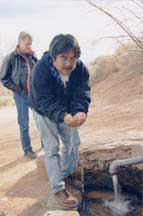 Leonard Selestewa draws water from Hopi springs. Leonard Selestewa draws water from Hopi springs.(Photo: Christopher Tomlinson) KRAKER: Leonard Selestewa, president of the grassroots group Black Mesa Trust and a Moenkopi farmer, scoops water out of one of his village's two springs and lets it fall through his fingers. SELESTEWA: I grew up where I thought this water would never go away, it would always run. You know, I grew up where there was a public spring where it discharged about 35 gallons per minute. I mean, this thing was just a big pipe out of a natural source of sandstone rock, artesian well. But gradually, I saw it all diminishing. Now, the spring by the village discharges roughly seven gallons per minute. And the wash is--half the year its gone. So you've got to wonder what's causing all this. KRAKER: The high desert of northeast Arizona is a parched landscape, receiving only about 10 inches of rain a year. The springs that gushed out of the sandstone cliffs are what drew the Hopi to settle here nearly a thousand years ago. Today they get their water from wells reaching down to the aquifer, but Selestewa says the springs still play a vital religious role. SELESTEWA: Everything revolving around our religious practices, and even the more secretive ones, they revolve around sacred springs. This is said to be the channels by which the spirits of the Kachinas travel. KRAKER: From the air, Black Mesa looks like a huge hand. Hopis call it the guardian hand, because it protects the water underneath. The Hopi villages are located on the tips of the mesa fingers, stretching south from the mine. On the palm is a metal building surrounding by enormous water tanks and coal bins, the center of the controversy. [MACHINE SOUNDS] KRAKER: Inside the Black Mesa pipeline works, the noise is deafening. Coal comes in on long conveyors. Giant metal rods swung back and forth like huge hammers crush it into a fine powder. It's then mixed 50/50 with the water to form a slurry. [MACHINE SOUNDS] KRAKER: Plant manager Andy Mikesell opens a door in the pipeline to reveal a thick, black, soupy pudding. From here, the mixture is pumped 273 miles to Mohave generating station in Laughlin, Nevada, where it's dried and burned to create electricity for Las Vegas, Phoenix, and Los Angeles. This is the only coal slurry in the country. [MACHINE SOUNDS] KRAKER: Back at the mine's offices, Peabody's environmental engineering manager, Brian Dunfee, shows on a projector the company's new 3D model of the aquifer. DUNFEE: We think that's probably what this is. KRAKER: He says it shows their pumping is equivalent to taking only half a soda can out of a 55-gallon drum. Dunfee doesn't doubt less water is flowing through Hopi springs and washes, but says it isn't because of Peabody. DUNFEE: Part of what's causing that is increasing groundwater usage in the villages and in surrounding Navajo towns. Water use is increasing. Part of it, we think, is due to climatic trends. Eventually, we think things will change for the better. KRAKER: The U.S. Geological Service in Flagstaff has been collecting data on Black Mesa since the 1970s. Hydrologist Blake Thomas agrees that increased pumping in area towns has had an impact on the aquifer, but he says Peabody is also to blame. THOMAS: Well, there has definitely been pretty large declines in the water levels, upwards of 100 feet or more in some places. And those are, of course, closer to the Peabody pumping. But the declines have been a result of both Peabody pumping and municipal pumping, because municipal pumping has been growing quite a bit. So it's kind of hard to distinguish how much of the drying out is coming from either source. KRAKER: The Natural Resources Defense Council has analyzed the government's and Peabody's data and come up with a third conclusion: that the company has already damaged the aquifer. NRDC attorney Andrew Wetzler says the issue has been studied to death and it's time to act. WETZLER: Yes. You don't need to have a Ph.D. in hydrology to know that withdrawing a billion gallons of water in a desert climate from the sole source of drinking water for a community is an extraordinarily bad idea. And I think that almost everybody agrees to that now. KRAKER: For the Hopi, the reality is their springs have been disappearing for a decade. And that leaves them an impossible choice between their income and their water. And they've chosen water. Hopi chairman Wayne Taylor has told Peabody it will have to leave when its lease expires in 2005 unless it can find an alternate source of water. The Hopi's argument is simple: without water, there's no life.
|

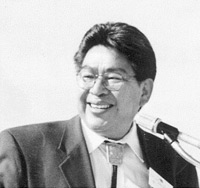 Wayne Taylor, Jr., Chairman of the Hopi Tribe, Arizona
TAYLOR: Well, of course, we come from the standpoint, which everybody will agree with, that water is our lifeblood. It's just unconscionable for anyone to be using pristine water such as we have here for industrial use.
Wayne Taylor, Jr., Chairman of the Hopi Tribe, Arizona
TAYLOR: Well, of course, we come from the standpoint, which everybody will agree with, that water is our lifeblood. It's just unconscionable for anyone to be using pristine water such as we have here for industrial use.

